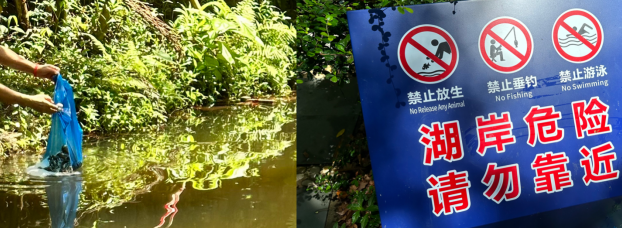Our choices in shaping nature's future
Writer: Matteo Convertino | Editor: Zhang Chanwen | From: Shenzhen Daily | Updated: 2023-11-27
The primary goal of this column is to inform individuals about ecosystem functionality, associated risks, and methods for managing ecosystems. While it is commonly assumed that ecological information alone can guide sound decision-making in the face of current and future challenges, in reality, decisions are often heavily influenced by development goals, neglecting ecological factors. Throughout Shenzhen’s development, particularly around the Shenzhen Bay area, choices have been heavily influenced by development objectives, without considering the functional structures – boundaries and natural corridors – of ecosystems.
本专栏的主要目标是让个人了解生态系统的功能、相关风险以及管理生态系统的方法。许多人认为,只要有生态信息,就能在当前和未来的挑战面前做出明智的决策,但事实上,决策常常受到发展目标的左右,而忽略了生态因素的重要性。在深圳的发展历程中,尤其是深圳湾地区,选择更多地考虑了发展目的,而没有充分考虑生态系统的功能结构——边界和自然廊道。
However, as our understanding of ecosystems grows, both successful initiatives and past errors should be made public to better guide protection, restoration, and optimal ecological function.
然而,随着我们对生态系统认识的不断加深,无论是成功的举措还是过去的错误都应该公开,以更好地指导保护、恢复和优化生态功能。
Ecosystems can be likened to financial portfolios, where the combined properties of aggregate systems tend to be less volatile than their individual components. The “portfolio” concept when applied to ecosystems provides insights into how ecosystems are supposed to be organized, how species interact, and how evolutionary strategies develop. It also provides a framework for managing risks posed by inevitable disturbances, many of which may be unpredictable.
生态系统就像金融投资组合,整体系统的属性往往比单个部分的波动性更小。当“组合”概念应用于生态系统时,可以深入了解生态系统如何组织、物种如何相互作用以及进化策略如何发展。它还为我们提供了一个管理不可避免的、可能难以预测的干扰风险的框架。

Fish releasing into water bodies: a common action seen across Shenzhen despite signals against it. Courtesy of Matteo Convertino
在深圳的一些水域,尽管有禁止放生的提示,人们还是时不时放生鱼类。
EcoBites, through its provision of ecological information, explores the collective organization of ecosystems and the values of people, all of which need to be integrated into the engineered design of nature, ideally mirroring nature’s optimal conditions.
EcoBites 通过提供生态信息,探索了生态系统的集体组织和人类的价值观,这些都需要整合到自然的工程设计中,尽可能地反映自然的最佳状态。
The main challenge lies in aligning "ecological norms," as defined by natural ecohydrological portfolios, with social norms to promote collective goods. This can be achieved through methods like education via mass media, as what we’re doing with EcoBites. Then, it's crucial to update ecological information continuously, as our understanding of nature is limited at any given time. For example, the importance of coastal wetlands in the carbon cycle was not widely recognized 40 years ago when the ecology of Dasha River delta was compromised.
最大的挑战在于如何将自然生态水文组合所定义的“生态规范”与社会规范相协调,以促进集体利益。这可以通过大众媒体教育等方式来实现,就像我们在EcoBites所做的这样。此外,我们还需要不断更新生态信息,因为我们对自然的理解在任何时候都是有限的。例如,40年前,当大沙河三角洲的生态遭到破坏时,人们并没有意识到滨海湿地在碳循环中的重要作用。
Monitoring ecosystem changes is essential for updating our knowledge of fundamental ecological processes, which should be disseminated not only through school education but also via media and nature centers. A continuous, widespread understanding fosters social progress, aligning individual behavior with broader ecological goals.
监测生态系统的变化对于更新我们对基本生态过程的了解至关重要,这些知识不仅应该通过学校教育传播,还应该通过媒体和自然中心传播。持续、广泛的理解有助于促进社会进步,使个人行为与更广泛的生态目标相一致。
Ultimately, in considering climate perspectives, our choices shape the climate we desire. Embracing an eco-engineering perspective necessitates aligning the assembly of nature's “Lego pieces” with both our needs and desires while remaining feasible and optimal within the natural realm grounded in the salient ecohydrological architecture of ecosystems. Individual components like buildings or species can no longer be viewed in isolation. Moving beyond mere protection and restoration, ecosystem engineering offers a clear detailed roadmap for sustainable global development. Integrated top-down and bottom-up decision-making, based on widespread ecological knowledge, guides our choices. Essentially, the choices we make form the foundational ecology.
最终,在考虑气候的角度时,我们的选择决定了我们想要的气候。我们要用生态工程的眼光看待自然,就要把自然的各种元素和我们的需要和想法结合起来,同时要在自然的限制下做到既可实现又最合适,还要考虑到生态系统的水文特征。像建筑物或物种这样的单个组成部分不能再孤立地看待。生态系统工程不仅仅是保护和恢复,还为全球可持续发展提供了清晰详细的路线图。基于广泛的生态知识,整合自上而下和自下而上的决策来指导我们的选择。从本质上讲,我们所做的选择构成了基础生态。